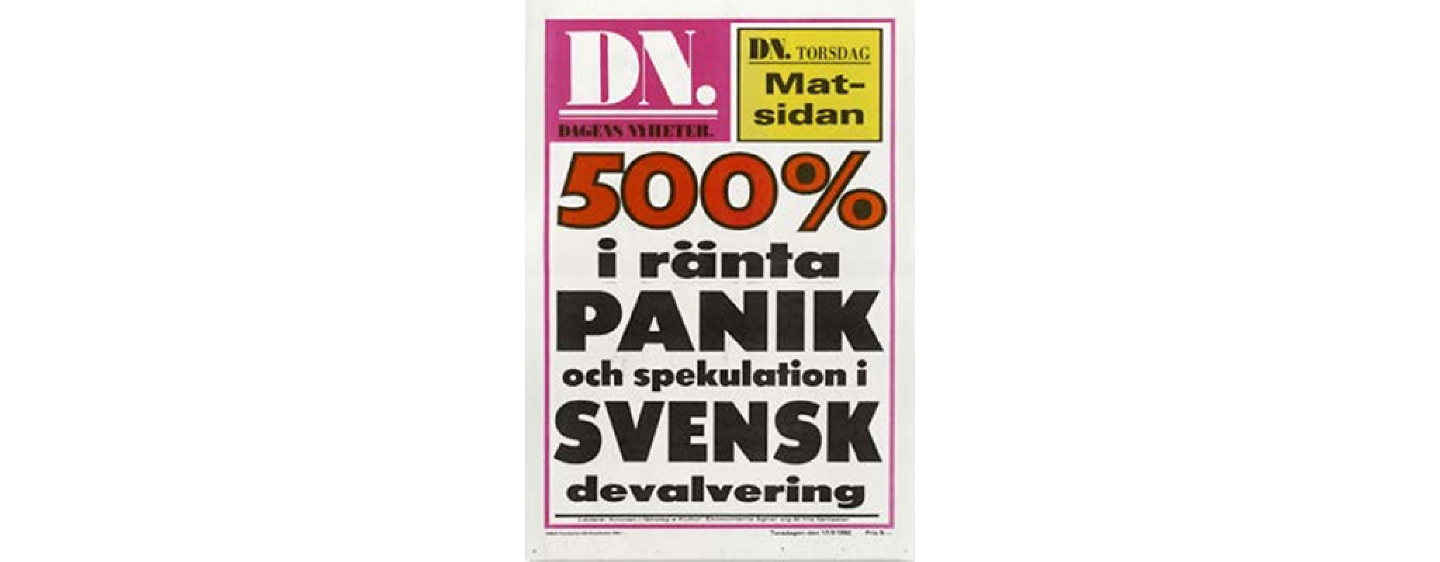1992 - Interest rate 500% – the krona floats

In autumn 1992, the Riksbank raised the interest rate to 500 per cent to defend the krona. This defence failed and the krona exchange rate was floated.
This dramatic development had its origin in the serious international recession of the 1990s and the side effects of German reunification. At the start of the 1990s, German reunification and the exchange of the East German mark for the Deutsche Mark at the rate of 1:1 led to strains on European currency arrangements. While the economies of the United States and the rest of Europe struggled, growth and inflation in Germany were high. This led the country to raise its interest rates and attracted foreign capital to Germany.
Sweden was ill-prepared for the international economic downswing and currency storms. Competitiveness was seriously impaired and the financial system was being shaken. The downturn was exacerbated by a tax reform that made households much more sensitive to interest rates than before. The real interest rate rose from 1–2 per cent in 1991 to occasionally over 10 per cent in the following year.
Deregulation and increased indebtedness also contributed towards the banking and financial crisis at the start of the 1990s. In Sweden, property companies went bankrupt, contributing to a banking crisis. Fiscal policy had not been tight enough, which contributed towards the economy becoming overheated with high inflation and weakened competitiveness. The Swedish krona was impacted by recurrent waves of speculation.
The Riksbank initially focused on trying to maintain the value of the Swedish krona. Early in the autumn of 1992, Bengt Dennis, the Riksbank and the Government attempted to stop the outflow of currency to hold the exchange rate steady. It was not enough. On 16 September 1992, following several rate rises over the course of a week, the Riksbank made a final attempt to stop the outflow and raised the marginal rate to 500 per cent.
Three days later, the Government and the social democratic opposition presented a joint crisis package. The Riksbank then cut the rate to 50 per cent. After a second crisis package, the rate was cut further to 24 per cent. This calmed the market somewhat and it became possible to lower the marginal rate to 11.5 per cent in the late autumn of 1992.
Despite the interest rate cuts, unease over the Swedish krona on the financial markets did not abate. Confidence in the value of the krona had largely been exhausted. Millions of krona continued to flow out of the country as investors chose other currencies ahead of the Swedish one.
Ultimately, neither the Riksbank nor the Government could avoid what they had spent several years trying to prevent. On 19 November, the fixed exchange rate was scrapped and the Swedish krona was allowed to float. It would take many years for Swedish society to recover from this.
However, the crisis resulted in insights that resulted in the Riksbank’s independent position being strengthened and its focus being changed. The rate of inflation finally slowed down. The crisis years also resulted in the framework for the budget process being established in law and the public pension system being reorganised. These changes and reforms equipped Sweden considerably better for future crises.
